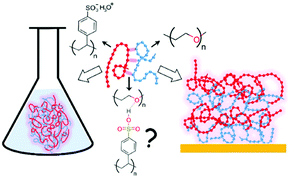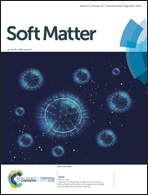Interpolymer complexes of poly(sulfonic acid)s and poly(ethylene oxide): an unexpected association†
Abstract
The formation of novel interpolymer complexes (IPCs) between poly(sulfonic acid)s and poly(ethylene oxide) (PEO) is reported. The complexes were precipitated from polymer mixtures in aqueous solution and deposited on surfaces as layer-by-layer films. Based on evidence from infrared spectroscopy, the interpolymer association in poly(sulfonic acid)/PEO IPCs is ascribed to hydrogen bonding between the sulfonic acid and the ether in PEO. This interaction is not anticipated because sulfonic acids are fully dissociated in aqueous solutions due to their strong acidity. Theoretical calculations suggest that the unexpected association of PEO and poly(sulfonic acid)s results from the formation of very strong sulfonic-acid/ether hydrogen bonds, which increase the apparent pKas of the poly(sulfonic acid)s and, therefore, decrease the net charge of these polymers. It is shown that while poly(styrene sulfonic acid) (PSSA) and Nafion form IPCs with PEO, poly(vinyl sulfonic acid) (PVSA) does not. This result is explained in terms of the hydrodrophobic nature of PSSA and Nafion, which stabilizes their IPCs, and the fact that hydrogen bonds in PSSA/PEO IPCs are predicted to be stronger than in PVSA/PEO IPCs.

- This article is part of the themed collection: Celebrating Latin American Talent in Chemistry


 Please wait while we load your content...
Please wait while we load your content...